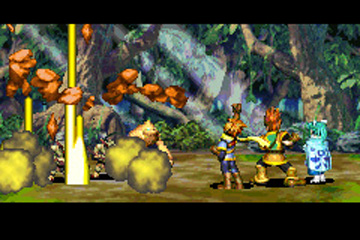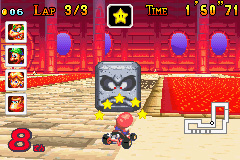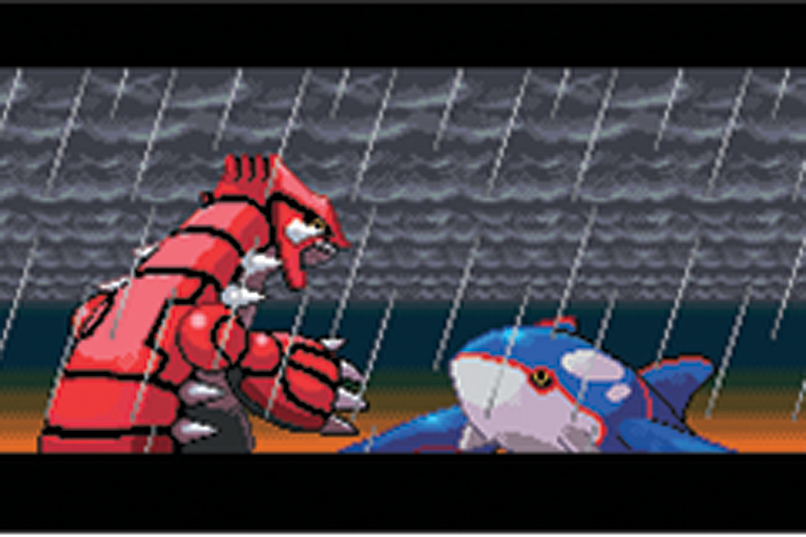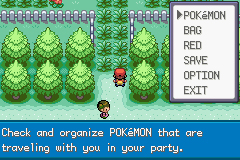Best GBA games: 20 classics we want to play on Nintendo Switch
The best games on Game Boy Advance.

Looking for the best GBA games? The Game Boy Advance wasn't Nintendo's greatest ever handheld, but it sold extremely well, had a great library of titles and had a fascinating history as a piece of hardware. The launch unit had a barely-visible screen, while the subsequent SP version introduced a backlight and clam shell design. Finally, before the generation was done, Nintendo introduced the GBA Micro, a console that was tiny enough to lose down the side of your sofa. Each iteration was radically different from the last, and all but the Micro were backwards-compatible with original Game Boy and Game Boy Color games, too.
The GBA introduced a number of key series to Western audiences, including Advance Wars and Fire Emblem. It was also a powerful enough upgrade over the Game Boy that Nintendo and other publishers could port a whole host of their beloved SNES games to the system, which gave its library a significant boost.
The DS, released a few years later, would be backwards compatible with the system. If you want to play these games now, the DS Lite might be your best bet, or you might even want to grab the upcoming premium handheld the Analogue Pocket, which will be compatible with all Game Boy games. You might also want to check out the line-up of GBA games available on Wii U, which is surprisingly extensive. Hopefully we'll see these games on Nintendo Switch Online some day, too.
Here, then, is our list of the best GBA games.
WarioWare, Inc: Mega Micro-Games!

WarioWare is a quickfire burst of 5-second games. Catch the toast as it pops out of the toaster! Balance the pizzas on a unicycle! Move Link into a cave! They're little shards of games with one objective, played one after the other in a random order, and it showcases Nintendo at its inventive best.
While you might want to consider getting WarioWare Gold on 3DS, which compiles the best microgames of the series into one pleasing compilation, no GBA collection should be without the first WarioWare game.
Advance Wars

Advance Wars may be a perfect strategy game for the GBA’s scope: you play a scrappy commander leading your army into modern combat, but on a turn-based system that lets you plan moves at your own pace. The small, colorful maps brighten up the tone and make it easy to see terrain features, while military units look fearsome yet cute in the game’s cherry, chibi-ish animation style.
Sign up for breaking news, reviews, opinion, top tech deals, and more.
But don’t let its pint-size features fool you: Advance Wars has all the incredible action you need with a balanced set of units and commanders (each with their own ability and superpower) enabling you to fight battles your way. The story is pretty average, though upbeat and enjoyable, with an assortment of colorful and wacky characters. Best of all, you can play against your friends – even on the same device by passing the GBA back and forth between turns.
Golden Sun

Golden Sun from developer Camelot Software was – and still is – a JRPG masterpiece that takes the best mechanics of Final Fantasy but condenses the narrative into something that’s more palatable for audiences both young and old. For older players, finding all the Djinn (elemental spirits that can be summoned for special damage) provided an additional challenge, while younger players could eke through by grinding and upgrading their armor.
Crafting a world that was both accessible and challenging simultaneously took the developers 18 months – a longer development time than many other GBA games made at the time – but the extra work clearly paid off for one of the handheld’s best games.
Final Fantasy Tactics Advance

If you’re looking for the GBA’s best Final Fantasy game, you’ll find it in Final Fantasy Tactics Advance. This tactical RPG offshoot from the main series takes place in Ivalice (a setting that would later be used by Final Fantasy XII) in various topographically unique locations. You’ll place each of these locations yourself – essentially creating your own unique game world – and each serve as a battlefield that has judges that have their own rules and regulations. Winning each battle required proper prepping by analyzing these rules and finding the best suitable cast of characters based on the environment – all of which made each battle feel wildly different from the last.
Just as interesting as the battle system, FFTA allowed you to recruit characters from the pub to build up your guild roster and then specialize those characters in more than two dozen classes. Skills in each class were taught by using various weapons and there was no upper limit on how many skills a character could learn. Later in the game, environments like the hard-as-nail Jagged battlefields could potentially cause permadeath for the characters which helped add some weight to the latter battles. Overall this is a timeless classic that we hope to see again on the Nintendo Switch at some point in its lifetime.
The Legend of Zelda: The Minish Cap

It’s a travesty that when ‘best ever Zelda games’ rankings are discussed, The Minish Cap barely gets a mention. Maybe it’s because it’s a handheld-only title. Maybe it’s because it is one of the few Zelda games to be made by a development team outside Nintendo – in this case, Capcom took the reins, as it did with the Oracles games on GBC. Whatever the reasoning, it’s unjust – we’d argue that The Minish Cap is among the best Legend of Zelda games ever released for a handheld.
It perfectly manages to distil the magic of the top-down Zelda games into a portable form, with excellent dungeon design, great items and powers to collect, and a really fun size-changing mechanic that sees Link shrink and grow to visit the pint-sized world of the Picori people. Shoutout goes to Ezlo, too, Link’s talking hat throughout the adventure, as great a companion as Navi before him or Midna after.
Mario Kart: Super Circuit

While the Game Boy and Game Boy Color had plenty of ambitious handheld entries in series that were peaking on SNES, like the Mario Land games or Link's Awakening, Mario Kart was always out of the handheld's reach. That's why Super Circuit was such a big deal: it was a complete Mario Kart experience translated to a handheld, presented in a similar sprite/3D effect style as the SNES original.
You race around themed Mario tracks, trying to take out other racers with items like red shells and bombs. The Mario Kart formula never disappoints, and this GBA entry was one of the system's most popular games. Four players could compete with a link cable, too, replicating the classic Mario Kart console experience on a smaller screen. While the later Mario Kart DS surpassed it, make sure you pick this up if you're starting a GBA collection.
Fire Emblem

The first Fire Emblem released in the West was actually the seventh entry in the series. The smash hit status of Intelligent Systems' Advance Wars, which featured similarities in its combat, reportedly boosted Nintendo's interest in taking the grid-based tactical RPG series outside of Japan. Strangely, we're now in a world where Fire Emblem is massive and Advance Wars has been dormant for over a decade.
This first entry has everything people still love about the series today: complex grid-based battles, characters you grow to really like and permadeath. You should probably start with Awakening on 3DS or Three Houses on Switch if you want to get into the series now, though.
Astro Boy: Omega Factor

Never heard of Astro Boy, one of the most famous manga creations of all time? Don't care about Astro Boy? It doesn't matter. This is the greatest 2D sidescrolling shooter on GBA, and it's easy enough that anyone can play it, which can't be said for all of developer Treasure's excellent shoot-'em-up games.
Adapting many elements of the manga and featuring a surprisingly well-embedded story, you have to finish Omega Factor several times to see the true ending, unearthing hidden levels and other secrets as you attempt to save the world. Clearly, lots of love for the source material went into this game, but it's the fantastic 2D shooting and beautiful visuals that make this a must-play title.
Tony Hawk's Pro Skater 2

There was a time when everyone had a board at their feet. Grinding, kick-flips and Ollies were the name of the game, and it was all because of the skating legend Tony Hawk and developer Neversoft Entertainment’s superb series of games.
Tony Hawk inspired a generation to try skateboarding for the very first time, and Tony Hawk’s Pro Skater 2 for GBA continued the series’ red hot streak. The 3D skating action transitioned wonderfully to Nintendo’s handheld, adopting an isometric, 3D-esque look that faithfully represented the console versions of the game.
Everything players loved about the Tony Hawk’s games was intact in the GBA release, with halfpipes to ride, rails to grind and a comprehensive number of tricks. The only disappointment was the absence of the console versions' classic soundtracks.
Metroid Fusion

Putting the Metroid in ‘Metroidvania’, Nintendo’s classic series returned to its roots with the critically-acclaimed Metroid Fusion. An eye-catching and vibrant color palette marked a stark change for Samus Aran’s previously monotone adventures and helped add new life to the sci-fi world for players to enjoy. Metroid Fusion also had a greater narrative focus than previous games, as Samus tries to recover her abilities and overcome a parasitic threat known as X.
In typical Metroid fashion, exploration and power-ups take center stage as you navigate labyrinthine levels full of hostile creatures and badass bosses. Previously restricted areas become available with the right power-up, and it’s always been super satisfying to backtrack to older sections that were previously out of reach.
Final Fantasy VI Advance

We could fill this whole list with SNES re-releases, since the GBA had so many of them. But Square's Final Fantasy series had a particularly strong run on GBA, as I, II, IV, V and VI all arrived on the system in good form, along with the aforementioned Tactics Advance.
Final Fantasy VI Advance is very expensive to buy now because it was one of the last games released on the system, but it was a perfect fit for Nintendo's handheld. Other than maybe Chrono Trigger, this is arguably Square's definitive 2D RPG, a gorgeous-looking and dramatic adventure set in a steampunk-infused world with a genuinely great story. It looked fantastic on that little screen, and while the audio from the original SNES version was compromised too much for some fans, this was an essential late-gen addition to the console library.
Pokémon Ruby, Sapphire and Emerald

After Pokémon's initial burst of popularity in the late '90s, it died down a little in the early part of the next decade, even if the series still shifted enormous numbers. Pokémon Ruby and Sapphire were the first GBA titles, while the Yellow-style third enhanced version of the game, Emerald, arrived a few years later.
Ruby and Sapphire brought double battles to the series as well as 135 new creatures, including a bunch of neat legendaries like Latios and Latias. Both received comprehensive and gorgeous 3DS remakes in 2014, which is the best way to enjoy them for the curious. These games don't represent the series' finest hour, exactly, but they showed that Pokémon was much more than a fad, and on GBA they came with a wireless adaptor for easy trading and battling between consoles.
Super Mario Bros Advance 2: Super Mario World

Despite picking the most long-winded naming convention possible for these re-releases of classic Mario games, the Mario Advance titles gave newer players the chance to check out the platforming plumber's greatest 2D hits.
We've just selected one to represent the whole sub-series, here, as Super Mario World still feels like the definitive 2D Mario game to us, but we'd be just as happy giving this slot to Super Mario Advance 4: Super Mario Bros 3 or Yoshi's Island.
The Legend of Zelda: A Link to the Past and Four Swords

While the Game Boy could handle Link's Awakening, a system-specific version of Zelda that translated the key elements of A Link to the Past to the low-power handheld, people had to wait until the GBA to get the SNES classic on the go. If you've never played it, this is still the definitive 2D Zelda, with many of the elements players would later love in Ocarina of Time coming from this game as players journeyed through two different versions of Hyrule.
These days, it's probably easier to just play A Link to the Past through Nintendo Switch Online, but this GBA version also came with the co-op Zelda adventure Four Swords. It was a treat for anyone fortunate enough to know three friends with GBAs and copies of the game back in the early '00s (which, to be fair, was probably a tiny number of people).
Sonic Advance 2

Do you remember what a big deal it was when Sega stopped production of the Dreamcast and started making games for Nintendo systems? The Sonic Advance games were quietly one the best exponents of that change, other than maybe Skies of Arcadia and F-Zero GX on GameCube. They brought Sonic back to his fast-paced 2D roots for the first time since the Neo Geo's Pocket Adventure game.
While the original Sonic Advance was the best-reviewed of the three, our fondest memories are of the superior second game. They're all pretty cheap to find on eBay these days, though, and they all still look fantastic on GBA SP or Micro.
Pokémon FireRed and LeafGreen

We get Pokémon remakes once a generation, now, and they started with this pair of overhauled Game Boy classics. FireRed and LeafGreen let players relive the journey from Pallet Town to facing the Elite Four, while also allowing them to trade creatures with Ruby and Sapphire once players got the National Pokédex.
These remakes would be surpassed by Pokémon SoulSilver and HeartGold on DS in their sheer amount of content, but the pixel art in these versions still looks fantastic.
Mario & Luigi: Superstar Saga

The first game in the long-running series, Mario & Luigi: Superstar Saga is a hilarious role-playing game that once again proved Nintendo has a wicked sense of humor. The game is filled with fan-service and recognizable characters from the Super Mario universe, and the onscreen action doesn’t disappoint, either.
You take control of the dungaree-sporting brothers as they venture beyond the Mushroom Kingdom to solve puzzles and take part in bonkers battles against equally bizarre enemies. The twist is that you’ll need to pay attention to enemy attack patterns and time your reactions just right to land powerful counterblows.
Recently remade for Nintendo 3DS, Mario & Luigi: Superstar Saga is a must-play for Mario fans who want to experience a fantastic role-playing game with a quintessentially clever spin on the formula.
Castlevania: Aria of Sorrow

Konami’s legion of Dracula hunters could really count on the GBA, which had three original Castlevania 2D side-scrollers that hold up to this day. While Castlevania: Harmony of Dissonance and Circle of the Moon were good, Aria of Sorrow was the third and most polished version of the series.
It gave us big bosses that took over this Game Boy’s 2.9-inch screen, more weapon variety, not just the whip from start to end, and the ability to trade collected souls with friends through the GBA link-up system. The developers also found a way to add some downright good music, a rarity on Nintendo’s cartridge system so limited in memory.
Ninja Five-O
There’s a reason that this game is going for more than $200 (£160, AU$320) on eBay right now. It’s one of the GBA’s unsung side-scrollers, even if we found its ninja-cop premise to be completely farfetched in 2003 (and still do today). The gameplay holds up as a Ninja Gaiden substitute on the Nintendo handheld that never got the more famous action series.
You were given a long sword, a bunch of ninja stars, and a Bionic Commando-like grappling hook to move through 2D levels and take out enemies. You weren’t able to just plow through the 20 levels like so many other beat-em-up games, though. Bad guys routinely shielded themselves with innocent hostages that you had to rescue, so it offered complexity in every frame, even before you got to the epic boss battles.
Jurassic Park 3: Island Attack
There are no truly-great Jurassic Park games. How that has been allowed to come to pass is beyond belief – it’s a multi-billion dollar franchise about resurrected rampaging dinosaurs, for crying out loud! It’s like someone missed the lecture on Gaming Concepts 101 when looking at Hollywood licenses to buy up and gamify.
We digress, because, actually, the Game Boy Advance had at least one rather good Jurassic Park game in the shape of Island Attack. An incredibly ambitious-looking game for a 16-bit handheld title, it’s an isometric action game very loosely based on the third Jurassic Park film. It has screen-filling spinosaurus dinosaurs, threatening raptors and even a motorcycle chase. It’s both incredibly tough and incredibly short, but its Resident Evil-lite mechanics are surprisingly well executed.
The TechRadar hive mind. The Megazord. The Voltron. When our powers combine, we become 'TECHRADAR TEAM'. You'll usually see this author name when the entire team has collaborated on a project or an article, whether that's a run-down ranking of our favorite Marvel films, or a round-up of all the coolest things we've collectively seen at annual tech shows like CES and MWC. We are one.